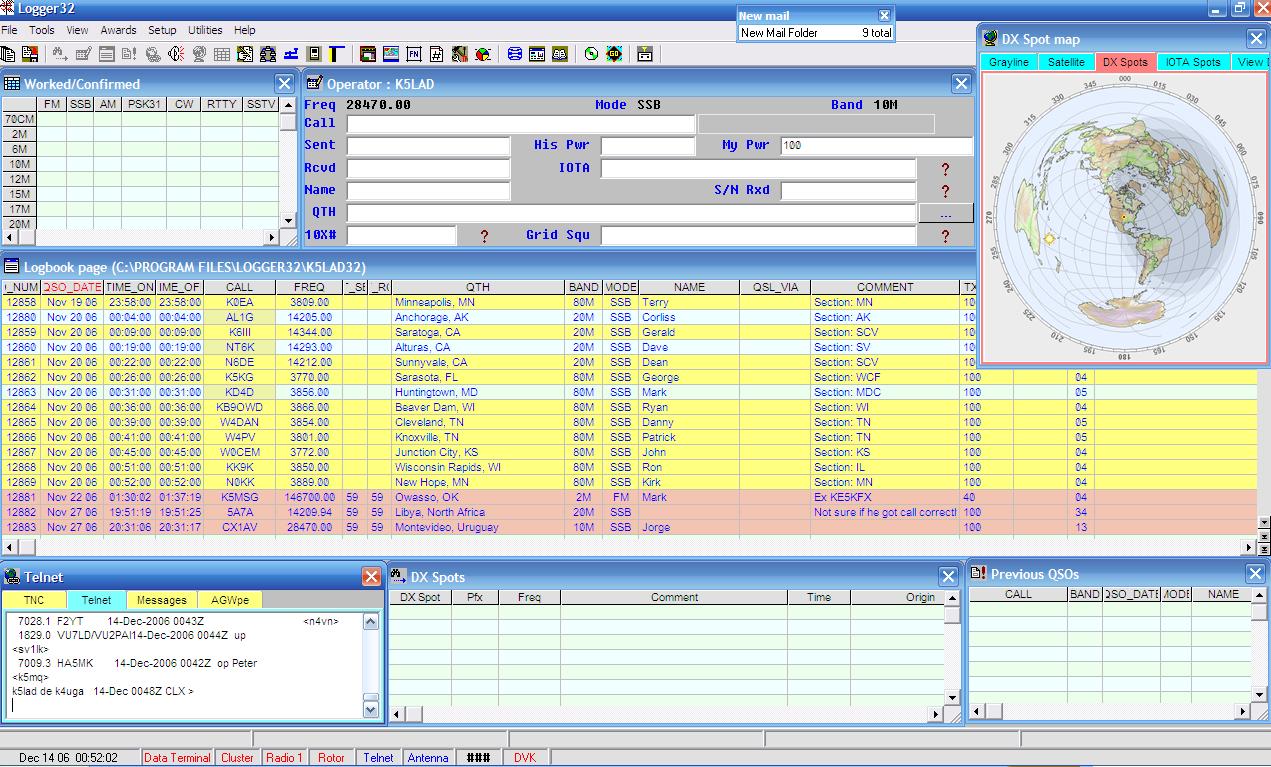Review of Logger32 Logging Program
Search keywords: Logger32, logging, logbook, good logbook
Imagine with
me, for just a moment, that you’re in a fancy restaurant and the waiter has just
brought your gourmet hamburger and another waiter has just served the table beside you
with a large steak with a nice baked potato, “loaded” as they say, and other
wonderful trimmings (but no broccoli 'cause I don’t like broccoli). Your hamburger looks, well…… OK, and it
will do as good a job in satisfying your hunger as that sumptuous meal being enjoyed
beside you but still……. And
then when the meals are finished and the waiters bring the checks, yours is plenty
bucks but the guy who got the steak dinner gets his entire meal for nothing. That’s right, FREE.

LOGGER32
has been developed to be a highly user-configurable, general-purpose amateur radio logbook
with computer control support for many radios and antenna rotators. It is NOT a contesting
log, although there is no real reason why it could not be used for such use, and does not contain
some features that might be found in software specifically designed for this activity. The
functionality that it DOES provide includes:
·
Compatible with early ADIF specifications
·
Logbook Page Window and Previous QSOs Window can each have up to 47 columns, all user configurable, including IOTA, Grid squares, satellite names, ten-ten etc.
·
Logbook, Previous QSO, and Worked/Confirmed windows can have the columns presented in any order
·
Seven user-definable log entry page items
·
Logs more than
1.5M QSOs
·
All Country,
County, and IOTA databases are fully editable
·
Displays sunrise/sunset, short path distance, long and short path beam headings, and local time for the distant end
·
Comprehensive
statistics tables for
Awards and QSLs, which can be drawn into MS Excel files for further
user presentations
·
Real time satellite tracking using Keps from a local file or collected from a favored web
site
·
DX spot tables with input from packet or telnet sources (or both at once)
·
User-definable
worked/confirmed color scheme on incoming spots.
·
Support for
many radios including a debug window
·
User-selectable frequency display in KHz or MHz down to 1 Hz resolution.
·
CDROM support for commercial logbook lists
·
Support for
the use of QRZ.com and GoList via the Internet
·
A facility to
synchronize your computer's clock to an atomic standard
·
All windows
fully re-sizeable
·
Supports multiple .INI files for different set-ups (normal, contest,
etc.)
·
Fully
configurable fonts, background, and foreground colors
·
Auto log-on
scripts for telnet and cluster access
·
Definable telnet and cluster shortcuts and scripts
·
Personalize
you own band plan
·
Prefix statistics available on screen for up to 50 bands
and 48 modes
·
Previously
worked callsigns automatically appear under the callsign entry window (Callsign preview)
·
Support for a
parallel port antenna selector that can operate automatically with your bandplan
·
Log page can be sorted on QSO#, Callsign, Prefix,
Frequency, Band, Mode, CQZ, DXCC, Grid Square, IOTA, State, Continent, and ITUZ.
·
Logs can be output in either ADIF or CSV format.
·
Supports both multiple user (One log for the family or Club station)
and multiple logs (one for the main, one for contesting etc)
·
Support
for eQSL and Logbook of the World (LoTW)
·
Export QSOs flagged
for QSLing
·
QSLs waiting to be sent are highlighted in the log.
·
Send
DX spots to a VHF cluster or Telnet
·
Built-in
version of Zakanaka (the Soundcard Data window) for PSK31/PSK63
and RTTY,
which includes:
Three independent, simultaneous receive channels in PSK31, Waterfall or spectral signal display.
Selectable colors for receive and transmit windows (Tx and
Rx windows).
Built-in macros for use with a selectable number of programmable “buttons”
Capture
his callsign and his name with a click.
Programmable default Rx (initial receive) frequencies
Independent AFC and squelch settings for each Rx window.
Selectable waterfall and spectrum display characteristics (color, brightness,
smoothing).
Operate RTTY (including 23 Hz.) using MMTTY module written by Mako Mori.
Calibrate the sound card timing
Operate split using audio tones or using radio control.
Save operating
parameters in RTTY mode in a “Profile”
·
Built in CW keyer (but NO decoder) with programmable
buttons and a limited range of macros
·
Support for automatic control of your antenna rotator
·
Contest serial number counter – up to 999,999 contacts
·
User-selectable
highlighting for worked, confirmed, QSL send, QSL awaiting printing and general editing
·
Single button
compression and saving of back up log files
·
Built in DVK (Digital Voice Keyer)
·
Built in Data Terminal with programmable buttons and a range of
macros
·
Simple conversion utility (Deg. C -> F. etc.)
·
DX Cluster spots can be displayed on a map
·
Selective filtering of DX spots
·
Synchronization
of log to download LoTW and/or eQSL records
·
Support for HamCap - a propagation prediction tool
written by VE3ENA
·
Support for a second CAT controlled radio
There are even more features but this should give you some idea of the completeness and adaptability of this program.
Logger is available for download at: www.logger32.net
Support is provided by users and those of us on the Beta team on the www.yahoogroups.com reflector called “hamlogger”
Oh yes, did I mention that it’s ?
=============================================================
Updated 12/01/07 01:31 PM
Page visited 1907 times